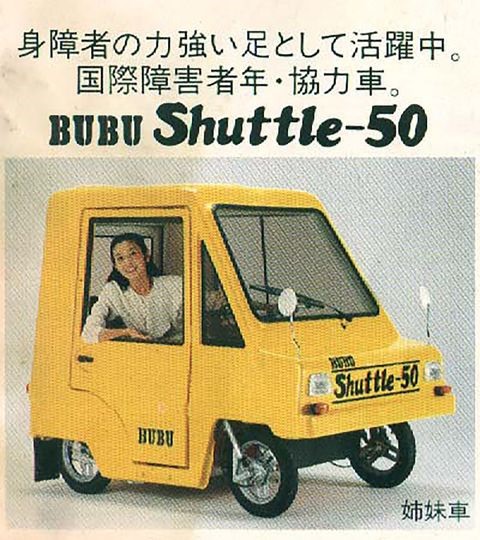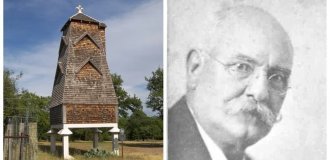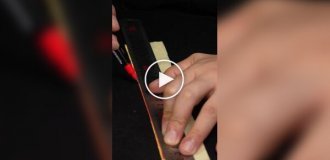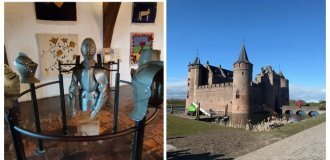The success of Mitsuoka, a Japanese custom car company (16 photos + 1 video)
Something is clearly wrong here. The front of the car, which stands in front of you, looks like a Chevy Blazer K5 from the eighties, but there is no nameplate in the form of a butterfly, and the proportions are noticeably different. 
Blazer has never been so small, and it has never been four-door hatchback. Friendly and familiar, but at the same time producing some supernatural impression. He came from the city of Toyama, located 250 miles (a little over 400 kilometers) from northwest of Tokyo. This is Mitsuoka Buddy (English "Buddy" or "Buddy"), the latest development of the most unexpected representative Japanese bodybuilding heritage. 

Handmade cars tend to be expensive European and exclusive. Buddy has more to do with the last one. In fact, Buddy is a big SUV of the old schools based on the Toyota RAV4 crossover costing from $45,000 (2 724,075 rubles at the rate of 60.54), sold out two years in advance. Quicker everything, you still won't be able to get it: Mitsuoka sells cars only in certain parts of Asia and Europe. 


However, Buddy and other models from the Mitsuoka line are more than just some wonderful curiosities from the country that gave us Pokémon and Hello Kitty. Mitsuoka is the youngest automaker Japan, but he continues the tradition of manual labor, numbering more than century. Today, the Japanese automotive industry is largely degree is based on rationalized mass production, with with which the Toyota chassis, which underlies the Buddy, was also created. Mitsuoka stands apart by offering unique vehicles to its customers hand-built, which are still affordable for the average consumer.
Want to drive an old school British sports car, but afraid of service problems? Mitsuoka's Himiko uses stuffing from Mazda Miata 
Japan's first breakthrough in mass production of cars was Mitsubishi Model A. From 1917 to 1921, only 22 luxury sedan, each of which had a closed rear, trimmed lacquered white cypress. Model A was not a commercial success but became a milestone in the rapid modernization of Japanese industry.
By the 1960s, Japanese automakers were independent, and the flagship models were made by hand. Toyota 2000GT, which later became the most collectible Japanese a classic, assembled by hand in collaboration with Yamaha. Cosmo, Mazda's first rotary-powered vehicle, was leaving the factory at Hiroshima on average once a day because the workers needed time for manual assembly.
The decade will come to an end before Japanese sports cars like the Datsun 510 and 240Z will become ubiquitous. By that time many Japanese motorists will switch to European brands: Jaguar, Alfa Romeo, MG, Triumph, Porsche and Fiat with Abarth modifications. Soon for import services, specialized workshops will appear. In February 1968 Susumu Mitsuoka registers the company under his own name, and Mitsuoka Jidōsha will open a car dealership shortly thereafter.
Jidosha is a slightly more formal term for a machine. in Japanese, equivalent to the word "car". The title partly alludes on Mr. Mitsuoka's ambition. He was especially encouraged by the British cars, and soon he began to serve the owners of various brands in Toyama prefecture.
Among the cars that ended up in the Mitsuoka workshop was a certain Italian microcar whose make and model data was lost in stories. Susuma could not find spare parts for repairs - unlike inspiration. Impressed by the machine's simple design, Mitsuoka decided create your own car from scratch. And by 1982 he had this happened.
The first car produced under the Mitsuoka Motor Co brand, was named Bubu Shuttle 50. The word "bubu" cars in Japan children call it, and Shuttle with a 50 cc engine was just tiny, slow and toy-like. However, he was considered very promising, because it was created specifically in order to inside could accommodate a driver in a wheelchair. Nowadays almost every Japanese manufacturer produces models designed formeant for disabled citizens. 
Later, Mitsuoka released a three-wheeled Bubu 501 and an absurdly square 502 (apparently, its design was developed solely with the help of lines). Besides the fact that they looked like movie props Studio Ghibli (a Japanese animation studio founded by Hayao Miyazaki and Isao Takahata), these small cars could be driven with a simple scooter license. Cars sold steadily, and soon this area opened Mitsuoka dealerships for the sale of used cars. The company grew. 
The real breakthrough came between the middle and the end eighties. The microcar market has been drying up since Japan new safety regulations came into force, and a small factory it was necessary to come up with something new to stay afloat. While traveling around Los Angeles, Mitsuoka noticed several popular kit car times (Wikipedia your time has come: "Kit car, also - "constructor car", "component car", - a car, which is sold as a set of parts that the buyer can assemble into the car either by yourself or wholly or partly entrust it third party"). He decided that the future of his company would lie in making copies. 
Bubu 505-C is considered the first such car, again with 50 cc engine, but already reminiscent of a miniature Jaguar SS100. under the hood hiding a single-cylinder engine with a capacity of 5 horsepower. released later Bubu Classic SSK became more typical of the era of imitation, in his appearance there were elements of the pre-war design of Mercedes - on the chassis from the Volkswagen Beetle. The Bubu 356 Speedstar, as you might expect, was replica Porsche 356 Speedster. 


Nothing they did was particularly innovative, but their efforts became the basis of the Mitsuoka recipe: take the usual consumer car, fill it with the charm of the old, and the result will be something that looks unusual, but does not cause unnecessary problems. Are you not tempted by the opportunity to purchase something similar to the Cruella De coupe Wil, and at the same time come to the local dealership for an oil change Nissan? This is exactly what Mitsuoka did when he created the neoclassical Le-Seyde based on fifth generation Nissan Silvia.
The timing was perfect. Japan was in full swing craze for neoclassicism, and for Nissan cars Pike Factory divisions in retro style lined up in huge queues. When Le-Seyde went on sale in 1990, all 500 cars were sold out within 72 hours. 

Mitsuoka built on this success with the release of Viewt, its longest-running project. It was based on the Nissan March, stylized as a Jaguar sedan. Mk II. He embodied all the best that the company's specialists did. Inside - an inexpensive compact sedan with an economical engine, excellent fit on the narrow country roads of Japan. Outside - a charming and whimsical adaptation of sixties British aesthetics. 
These are really special cars. luxury manufacturers cars such as Bentley and Rolls-Royce are often made press releases that extol the craftsmanship of the creators. Each the Mitsuoka model is also the result of the work of two experienced masters. Working predominantly in pairs, Mitsuoka plant employees collect one or two copies a day. Depending on the model, production of one car can take 30 to 60 days.





















